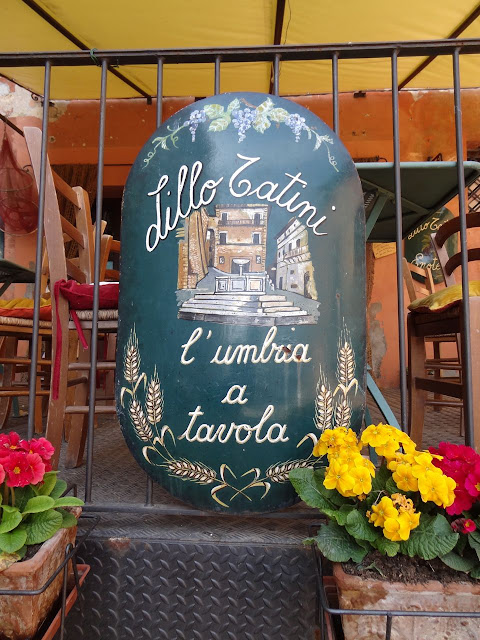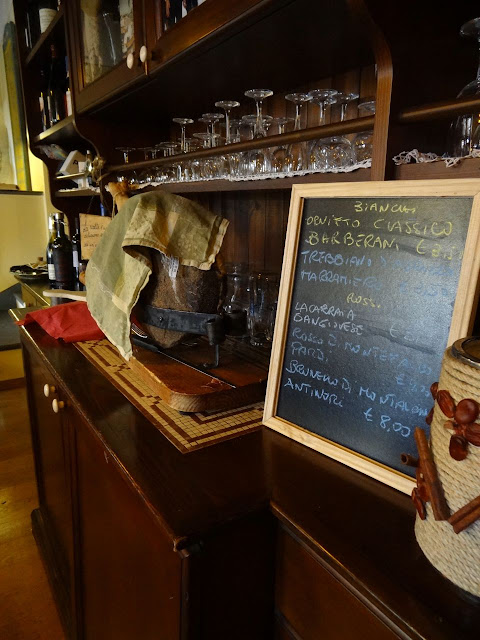While Panicale has probably been inhabited since Etruscan times, it was a medieval castle built on the peak of the hill that formed the village we see today. One of the most beautiful towns in Italy, along with Paciano, they have both been crowned 'I Borghi piu belli d'Italia', the Italian equivalent to the Plus Beaux Villages of France — small villages throughout their respective countries that are considered to be the most beautiful. These two idyllic Italian villages, Paciano and Panicale, although intact medieval microcosms, are also living towns, where increasing numbers of people are returning to live. Increasing numbers of visitors have also recently become more interested in learning about these two villages, finding the atmosphere, local customs, traditions and way of life, one that is worth savouring with all five senses. And it's with this passion that we've come to Panicale on this gloriously sunny day, in search of one of Italy's most famous painters, Pietro Vannuci, known as Il Perugino, and Lillo Tatini, one of the culinary artisans of Panicale — but more on that later.
An ancient Medieval covered walkway leading to Piazza San Michele
The origins of Panicale date back to the Etruscans who inhabited the area in the 7th-century BC. The town became a secure refuge for the Roman soldiers who survived the battle of Lake Trasimeno, won by Hannibal and the Carthaginians. In 1037, after the fall of the Roman Empire and after the end of the Longobard domination, Panicale became one of the first Italian communes to declare itself independent with its own autonomous government. Considered one of Italys most important and fortified towns, the walled castle town of Panicale resisted all attempts to being captured until 1643, when the armies of Florence conquered it during the war between the Papal State and the Duchy of Parma. Panicale finally fell under the Churchs domain, until the Kingdom of Italy was founded in 1861. Not surprisingly, art is everywhere in Panicale.
The beautiful 15th-century travertine fountain in Piazza Umberto I
Entering the town through the Perugia Gate is the 15th-century fountain made of travertine marble. This used to be the town's ancient water well and extended underneath the whole square. It was later turned into a fountain in the early 1900s. From the same spot, the rear walls of the impressive Collegiate Church of Saint Michael the Archangel can be seen. The Church, dating back to the 11th-century has a typical Baroque interior design. In the apse is "The Annunciation" fresco attributed to Tommasino Fini, known as Masolino, and on the rear left side, "The Adoration of the Shepherds" by Gianbattista Caporali, a student of Il Perugino.
Collegiata di San Sebastiano in Piazza San Michele
Bronze sculpture of St. Michael the Archangel in a niche outside San Sebastiano
Unfamiliar with the story of St Michael the Archangel, I soon learned that he is the patron saint of warriors. The bronze sculpture outside San Sebastiano is a depiction of St Michael waging battle against the forces of darkness. In 1884, after supposedly seeing a frightening vision, Pope Leo XIII wrote 'The Saint Michael Prayer':
Saint Michael the Archangel,
defend us in battle.
Be our protection against the wickedness and snares of the devil.
May God rebuke him, we humbly pray;
and do Thou, O Prince of the Heavenly Host,
by the Divine Power of God,
cast into hell, satan and all the evil spirits
who roam throughout the world seeking the ruin of souls.
The stately stone entry of 11th-century San Sebastiano
The interior, sumptuously decorated in the Baroque style
The 15th-centry "Annunciation of the Virgin" by Masolino da Panicale
"The Adoration of the Shepherds" by Gianbattista Caporali, a student of Il Perugino
An enchanting ceramic tile map of Panicale sits under the gated arch of Porto Perugino, and gave us a good idea where to find The Church of St. Sebastian, home to Perugino's famous "Martyrdom of St. Sebastion". Walking uphill along Via Pietro Vannucci, we arrived at the church, only to find that it was closed! A sign on the door said it was only open by appointment through the Sistema Turistico Locale del Trasimeno, the local tourist office, just around the corner.
A lovely ceramic tile map of Panicale is under Porto Perugia
Not be be outdone, we went in search of the elusive "master of the keys" and found him hiding in a tiny office in Piazza dell'Ospedale. We were informed that he did have the keys to the church, as well as all of the other museums and churches in Panicale, but due to a lack of funding, he was the only person who was permitted to escort tourists interested in visiting Panicale's historic sites. Being off-season in Umbria, we were the first visitors he'd had that day, and were going to get a private guided tour of St. Sebastian's precious Perugino and Raphael frescoes! We couldn't believe our good fortune.
Our guide opening Chiesa di San Sebastiano just for us!
"Il Martirio di San Sebastiano" by Perugino
Pietro Perugino painted 'The Martyrdom of Saint Sebastian' in the Church of Saint Sebastian as a fresco, on wet plaster, so it had to be painted quickly, in stages over a period of time. Having completed the fresco, the city didn't have the money to pay Perugino, so he departed in search of other commissions, and returned a year later. A consortium of businessmen had since raised the funds to pay the artist, but they had terms — they wanted to be painted into the fresco. On the far left and right of the painting are two faint groups of men — the backers. Perugino tried to explain that he couldn't 'paint' them into the fresco, as the plaster had already dried and wouldn't absorb the pigment, but they wouldn't listen. So Perugino added the figures a secco, on dry plaster, which does not last. So according to our guide, "Justice was done." The businessmen had tried to strong-arm Perugino, and they are now slowly disappearing from the fresco!
A serene San Sebastiano
Close up detail of Perugino's fresco
An archer preparing his bow, about to slay St. Sebastian
A small corner of Perugino's fresco where you can actually see the brushwork
In the same church there was also the breathtaking fresco depicting the 'Madonna in trono con Angeli musicanti', which has only recently been attributed to Raphael. It was taken from the St. Augustine Church in 1884, and is now being preserved in the Church of Saint Sebastian. Painted by students of Perugino, one of the startling revelations has been that four of the figures in the fresco, the Musical Angels, were all painted by Raphael, at age 12. It was an extraordinary experience to be able to get so close to these works of art, in private, and in total quiet. No tourists. No noise. It was ethereal.
The detached fresco "Madonna in Trono", or Madonna and Musical Angels, by Raphael
Detail of the Raphael
Figures painted by Raphael when he was a 12-year old student of Perugino
Having had our private guided tour, the church was locked again for the day
Overwhelmed with our good fortune to have just been 'up close and personal' with two of the most important artists in the history of Italian art, and having had the unique opportunity of enjoying the frescoes in the privacy of our own company, was such a special gift that we'll treasure for a long time to come, and truly one of the highlights of our trip to Umbria. Fortified with the art of Perugino, it was time to fortify our bodies with the special Umbian cuisine of Lillo Tatini, a lovely little restaurant on Piazza Umberto I.
Lillo Tatini perched at the top of Piazza Umberto I
L'Umbria a Tavola — Umbria on the table — serving traditional cuisine from the area
Patrizia, her husband Vittorio and the chefs
The wonderfully charming interior
The sideboard with a wrapped prosciutto locked in its slicing stand
Colourful jacquard napkins laid at every place setting
The new Lillo Tatini menu made with suede and handmade paper
and fastened together with a silk cord
A wonderful aperitif — bright orange Aperol with Prosecco and a slice of blood orange
Our new signature summer drink
Fresh warm bread and homemade scones nestled in a wicker basket
and wrapped in an locally embroidered cloth
A small pot of addictive anchovy and caper butter
Fagiolino del Trasimeno con extravergine olio
Lillo Tatini's divine Crema di Ceci e Baccala alle Prugne
Zuppa di Ceci e Costagna con pane tostata
Carbonara del Perugino: Ravioli ripini con uovo quaglia saltati in padella con pancetta
di Cinta Sense e ricotta stagionata di Norcia
A close up of the extraordinary ravioli, each stuffed with a little quail's egg
Polpine di Cinghiale speziale e cipolline in agrodolce
Spntino al Poggia: Coratina di Agnello in corrido con verdure cotta di stagione
Ristorante Lillotatini
Piazza Umberto I - 13
Panicale, Umbria
Walking back uphill to our car after our decadent, but delicious lunch
The beautiful old wooden doors to Palazzo del Podesta
A view overlooking the valley below
Leaving Panicale through the Florentine Gate, is the former 16th-century Saint Augustine Church, which since 2001 has housed the Museo del Tulle. Inside the church there are remains of antique frescoes attributed to Perugino's school and a precious 14th-century altar made by Giambattista di Cristoforo from Cortona. The museum highlights embroidery pieces that are typical of the Panicale needlework technique known as 'Ars panicalensis'. This handmade embroidery on tulle was revived in the early 1900s by Anita Belleschi Grifoni, to whom the museum is dedicated.
Panicale's Medieval Florentine Gate
At the age of forty, inspired by the records of the original practitioners, Anita Belleschi Grifoni decided to keep the art of embroidery on tulle alive. The ancient practice had its origins in many of the local churches, principally from the Collegiate Church of St. Michael Archangel, which is considered to be the birthplace of Ars Panicalensis. Anita’s designs, in accordance with the art style of the 19th century, are mainly composed of flowers, spirals and scallops, love knots, ribbons, swallows and country decorations. Enormously popular, her designs are now shipped all around the world. Of course, the Museum was closed — you have to talk to our friend, 'the master of the keys' in the Sistema Turistico Locale del Trasimeno, to let you in! Buon fortunato.
The Tulle Embroidery Museum
























































